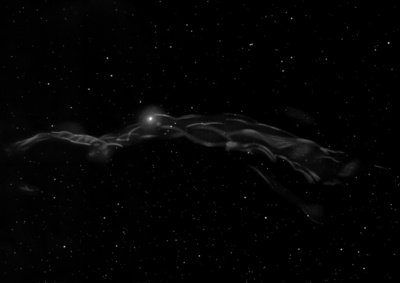Veil Nebula
Veil Nebula

11x80 (5/26/84): both sections of Veil are easily visible in the 11x80 finder using a filter.
15x50 IS binoculars (8/27/11): the entire Veil was visible (eastern section was striking) using a pair of UHC filters threaded over the objectives. The western section through 52 Cygni took more care to view and the forked southern half was the most difficult section to pick up.
William Herschel discovered NGC 6960 = H V-15 = h2088 on 7 Sep 1784 (sweep 259) and recorded "Extended from one number to the other [in declination]; pB, taking in 'k' [52] Cygni in its extent. The milky ray is convex towards the following side in that part which lies north of k, pretty compact and equally bright. On the southern side of 'k' it is less bright and at last loses itself with some extension, perhaps in two braches, but it is not bright enough that I may determine this circumstance with certainty. The breadth of the northern parts is near 2', the southern branch is less defined." Soon after in the same sweep he encountered NGC 6979 (the northern section of the Veil). On the previous night (sweep 258) he discovered NGC 6992, the main eastern portion of the Veil and
JH recorded 3 observations. On sweep 178 he noted "The place is that of k Cygni, through which the nebula passes. It is very long and winding and runs northward from k full 2 fields breadth (30'). One branch is pretty conspicuous, even in a little moonlight. The nebulosity is milky, and does not seem to arise from small stars of the Milky Way." Isaac Roberts took the first photograph of the NGC 6960 on 28 Sep 1891.
300/350mm - 13.1" (5/21/82): this is the prominent western section of the "Veil nebula" and is spectacular with an OIII filter. Bright, extremely large, very elongated N-S, stretches across the entire low power field while passing through the bright unequal double 52 Cygni = 4.3/9.5 at 6". Fans out to the south and splits into two delicate branches and fainter wisps. The bright curving nebulosity north of 52 Cygni has a remarkable "electric" quality. It has an abrupt bend about midway and then tapers down to a narrow tip towards the north end gently bowing out towards the west side. Fantastic detail using a 20mm Nagler and OIII filter.
Notes by Steve Gottlieb